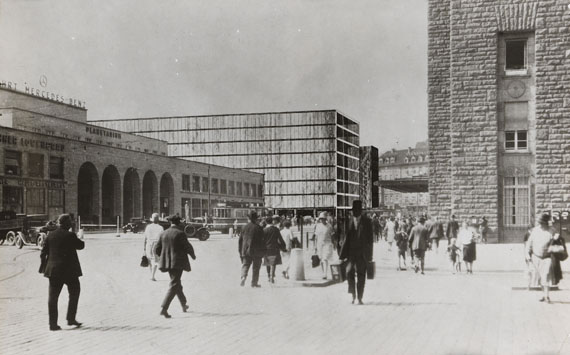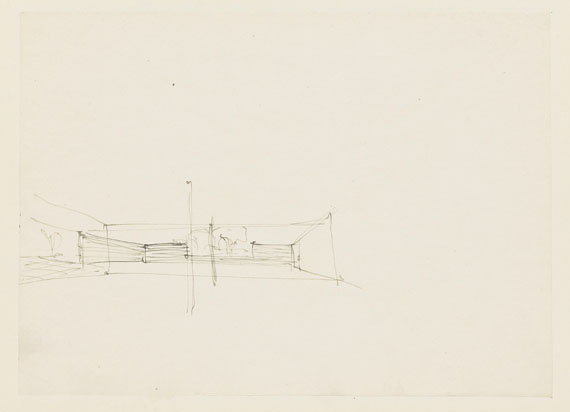Ludwig Mies van der Rohe Pair of “Barcelona” chairs, model no. 250, and a “Tugendhat” table, model no. MR 150 ca. 1955-1958 Chairs: chrome-plated steel, leather; table: chrome-plated steel, glass. Each chair: 29 in. (73.7 cm.) high; table: 18 3/4 x 38 1/2 x 38 1/4 in. (47.6 x 97.8 x 97.2 cm.) Manufactured by Waldemar Stiegler for Knoll International, Germany (3).
Provenance Private Collection, Berlin Literature Chairs: Mobilia, March 1958, np.; Alexander von Vegesack and Matthias Kries, Mies van der Rohe: Architecture and Design in Stuttgart, Barcelona, Brno, Geneve, 1998, pp. 69-70; Christiane Lange, Ludwig Mies van der Rohe & Lilly Reich Möbel und Räume, Krefeld, 2006, pp. 174-75; Helmut Reuter and Birgit Schulte, eds., Mies and Modern Living: Interiors, Furniture, Photography, Ostfildern, 2008, p. 184, fig. 188 for an advertisement by Knoll International. Table: Ludwig Glaeser, Ludwig Mies van der Rohe Furniture and Furniture Drawings from the Design Collection and the Mies van der Rohe Archive, New York, 1977, p. 60; Terence Riley and Barry Bergdoll, eds., Mies in Berlin, New York, 2001, p. 45 Catalogue Essay Phillips de Pury & Company would like to thank Dr. Hans Deuerler, Mies van der Rohe expert, and Dr. Friederike Deuerler, Department of Mechanical Engineering, Bergische Universität Wuppertal, Germany, for their assistance cataloguing this lot. Since their first appearance in the German Pavilion at the 1929 International Exposition in Barcelona, Mies van der Rohe’s cantilevered “Pavilion” or “Barcelona” chairs have been produced by a variety of firms and have undergone a number of modifications in material and manufacture. In Mies and Modern Living (2008), Helmut Reuter and Birgit Schulte refer to the very rare pre-war examples as “Pavilion” chairs and postwar examples as “Barcelona”. They trace nineteen of the former and believe that only approximately two dozen pre-war chairs may have been produced in total, likely all of them by Berliner Metallgewerbe Jos. Müller, a small company which supplied the furnishings and metal fittings for the Barcelona pavilion as well as Mies’s Tugendhat House in Brno. Although production of the chairs in Germany stopped prior to the Second World War, it resumed again in 1954 when Waldemar Steigler, a metalworking company in Marbach am Neckar, began manufacturing them as Model no. 250 for Knoll International, the first overseas branch of Knoll Associates. The present chairs, assembled from separate side pieces and cross bars similar to prewar examples, date from Waldemar Stiegler’s early postwar production. Read More
Ludwig Mies van der Rohe Pair of “Barcelona” chairs, model no. 250, and a “Tugendhat” table, model no. MR 150 ca. 1955-1958 Chairs: chrome-plated steel, leather; table: chrome-plated steel, glass. Each chair: 29 in. (73.7 cm.) high; table: 18 3/4 x 38 1/2 x 38 1/4 in. (47.6 x 97.8 x 97.2 cm.) Manufactured by Waldemar Stiegler for Knoll International, Germany (3).
Provenance Private Collection, Berlin Literature Chairs: Mobilia, March 1958, np.; Alexander von Vegesack and Matthias Kries, Mies van der Rohe: Architecture and Design in Stuttgart, Barcelona, Brno, Geneve, 1998, pp. 69-70; Christiane Lange, Ludwig Mies van der Rohe & Lilly Reich Möbel und Räume, Krefeld, 2006, pp. 174-75; Helmut Reuter and Birgit Schulte, eds., Mies and Modern Living: Interiors, Furniture, Photography, Ostfildern, 2008, p. 184, fig. 188 for an advertisement by Knoll International. Table: Ludwig Glaeser, Ludwig Mies van der Rohe Furniture and Furniture Drawings from the Design Collection and the Mies van der Rohe Archive, New York, 1977, p. 60; Terence Riley and Barry Bergdoll, eds., Mies in Berlin, New York, 2001, p. 45 Catalogue Essay Phillips de Pury & Company would like to thank Dr. Hans Deuerler, Mies van der Rohe expert, and Dr. Friederike Deuerler, Department of Mechanical Engineering, Bergische Universität Wuppertal, Germany, for their assistance cataloguing this lot. Since their first appearance in the German Pavilion at the 1929 International Exposition in Barcelona, Mies van der Rohe’s cantilevered “Pavilion” or “Barcelona” chairs have been produced by a variety of firms and have undergone a number of modifications in material and manufacture. In Mies and Modern Living (2008), Helmut Reuter and Birgit Schulte refer to the very rare pre-war examples as “Pavilion” chairs and postwar examples as “Barcelona”. They trace nineteen of the former and believe that only approximately two dozen pre-war chairs may have been produced in total, likely all of them by Berliner Metallgewerbe Jos. Müller, a small company which supplied the furnishings and metal fittings for the Barcelona pavilion as well as Mies’s Tugendhat House in Brno. Although production of the chairs in Germany stopped prior to the Second World War, it resumed again in 1954 when Waldemar Steigler, a metalworking company in Marbach am Neckar, began manufacturing them as Model no. 250 for Knoll International, the first overseas branch of Knoll Associates. The present chairs, assembled from separate side pieces and cross bars similar to prewar examples, date from Waldemar Stiegler’s early postwar production. Read More












Testen Sie LotSearch und seine Premium-Features 7 Tage - ohne Kosten!
Lassen Sie sich automatisch über neue Objekte in kommenden Auktionen benachrichtigen.
Suchauftrag anlegen